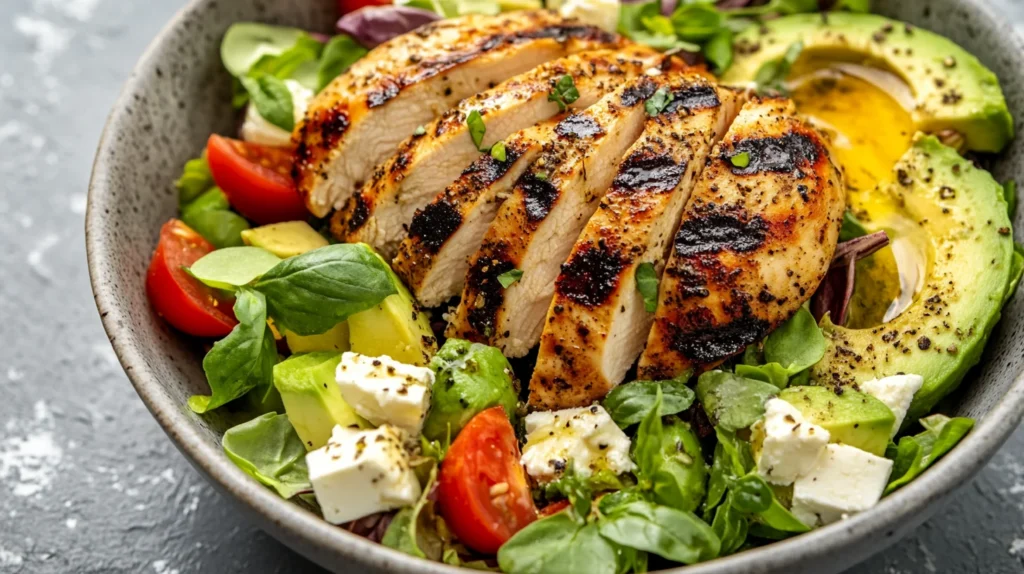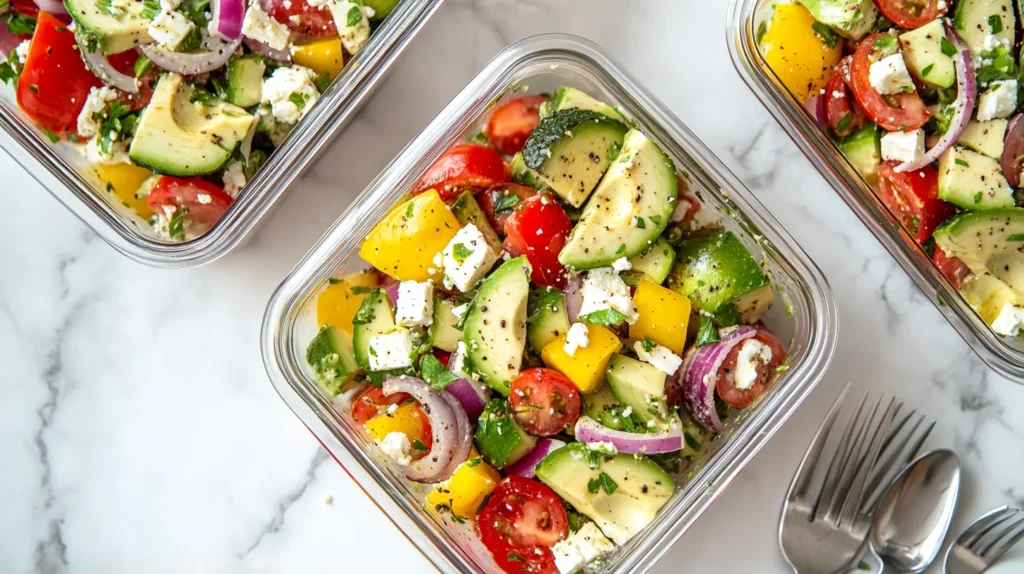There’s something truly magical about Mediterranean cuisine. From the bright colors to the bold flavors, every dish tells a story of sun-drenched coasts, family traditions, and centuries-old recipes. Among these flavorful gems, one dish has made its way into kitchens around the globe: the Avocado Feta Greek Salad.
This modern twist on a classic favorite brings together the creamy richness of avocado and the salty tang of feta cheese, set against a vibrant medley of fresh tomatoes, cucumbers, red onions, and olives. Tossed with a light olive oil and lemon dressing, the Avocado Feta Greek Salad is a celebration of both flavor and nutrition.
But why has this salad gained such a devoted following? It’s not just because it tastes amazing (although that’s a big part of it). It’s because it hits all the right notes—fresh, filling, healthy, and easy to make. Whether you’re preparing a weekday lunch, a dinner side dish, or something impressive for a summer gathering, this salad checks every box.
In this comprehensive guide, we’ll explore 10 powerful reasons why the Avocado Feta Greek Salad is a must-have in your recipe collection. From its historical roots and health benefits to preparation tips and exciting variations, this article is your go-to resource for everything about this Mediterranean masterpiece.
So grab your chopping board, a ripe avocado, and a block of feta—let’s dive into the delicious world of Avocado Feta Greek Salad!

The Origins of Greek Salad
To truly appreciate the Avocado Feta Greek Salad, it helps to understand its roots. Traditional Greek salad, known in Greece as Horiatiki, is a rustic dish that reflects the simplicity and vibrancy of Mediterranean living. It’s not just a meal—it’s a representation of local culture, seasonal ingredients, and a healthy way of eating that has stood the test of time.
Traditional Greek Salad Ingredients with Feta Cheese
A traditional Greek salad typically features a short but powerful list of ingredients: ripe tomatoes, crisp cucumbers, thinly sliced red onions, green bell peppers, dark Kalamata olives, and generous chunks of feta cheese. This colorful medley is dressed in extra virgin olive oil, sometimes with a splash of red wine vinegar, and sprinkled with dried oregano.
What makes this dish so beloved is its reliance on freshness. Greeks take pride in using what’s in season and grown locally. The salad doesn’t need lettuce or complex dressings—its charm lies in letting each ingredient shine naturally.
In many rural parts of Greece, this salad is served almost daily during the summer months, often accompanied by crusty bread and a glass of local wine. It’s not just food; it’s an experience of communal eating and seasonal abundance.
How Feta Enhances Classic Greek Salad Recipes
No Greek salad would be complete without feta cheese, and it plays a starring role in the Avocado Feta Greek Salad as well. Feta is a brined curd cheese traditionally made from sheep’s milk, or a mixture of sheep’s and goat’s milk. Its texture is crumbly and moist, and its flavor is sharp, tangy, and unmistakably Greek.
In Greece, feta is more than an ingredient—it’s a culinary heritage. In fact, the name “feta” is protected under European Union law, meaning only cheese produced in certain regions of Greece using traditional methods can bear the name.
The cheese adds not only depth and richness to salads but also contributes a healthy dose of calcium and protein. Its saltiness contrasts beautifully with the juicy tomatoes and the smoothness of the avocado, creating a perfect flavor harmony.
As we layer avocado into the classic Greek salad, the result isn’t a complete reinvention but rather a fresh and creamy upgrade that still honors its Mediterranean roots. This is why the Avocado Feta Greek Salad is loved by both purists and modern food lovers alike—it bridges tradition with creativity.
What Makes Avocado Feta Greek Salad Unique
While the classic Greek salad is already a culinary favorite, the addition of avocado takes it to a whole new level. This creamy, nutrient-rich fruit adds more than just flavor—it brings texture, health benefits, and a sense of indulgence. Combine that with salty feta and fresh vegetables, and you’ve got a dish that’s as delightful to eat as it is good for you.
Why Creamy Avocado Is Perfect in Greek Salads
Avocado is often referred to as “nature’s butter”—and for good reason. Its rich, smooth texture provides a beautiful contrast to the crunch of cucumbers and the juiciness of tomatoes in a Greek salad. When diced and gently folded into the salad, avocado adds a creamy, luscious mouthfeel that elevates every bite.
But it’s not just about texture. Avocados are packed with monounsaturated fats, especially oleic acid, which is known to support heart health and reduce inflammation. They’re also a fantastic source of vitamin E, potassium, and B vitamins. All of this makes avocado a smart and satisfying addition to an already healthy dish.
The flavor of avocado is mild yet distinct, allowing it to blend effortlessly with the other ingredients without overpowering them. It absorbs the flavors of the dressing while lending a buttery undertone that ties everything together.
The Salty Tang of Feta
Feta cheese, with its briny, slightly tangy taste, balances the mildness of avocado beautifully. It cuts through the creaminess with its sharp, savory edge, providing a flavor anchor that keeps the salad bright and balanced.
In the Avocado Feta Greek Salad, feta often takes center stage. Whether crumbled or sliced into cubes, it adds not only flavor but also visual appeal with its stark white contrast against the greens and reds of the vegetables.
When paired with the soft texture of avocado, feta provides a delightful textural contrast—crumbly yet firm, creamy yet sharp. It’s this play of opposites that makes each forkful an exciting mix of taste and texture.
Fresh Mediterranean Vegetables in Avocado Feta Salad
Let’s not forget the supporting cast: crisp cucumbers, ripe cherry tomatoes, paper-thin red onions, and sometimes even crunchy green bell peppers. These veggies aren’t just filler—they’re essential to the Mediterranean identity of this salad.
Each vegetable brings something to the table:
- Cucumbers offer crunch and hydration.
- Tomatoes add sweetness and acidity.
- Red onions give a bit of zing.
- Olives deliver bold, briny richness.
Together with avocado and feta, they form a harmonious blend of textures and tastes that’s both refreshing and deeply satisfying. Toss it all in a simple dressing of extra virgin olive oil, lemon juice, garlic, oregano, salt, and pepper, and you’ve got a salad that’s far from ordinary.
This is what makes the Avocado Feta Greek Salad stand out. It’s a dish where no ingredient goes unnoticed, where nutrition meets indulgence, and where classic Mediterranean flavors are given a fresh, modern twist.
Health Benefits of Avocado Feta Greek Salad
The Avocado Feta Greek Salad isn’t just a treat for your taste buds—it’s a nutritional powerhouse. With its blend of fresh vegetables, healthy fats, and high-quality dairy, this salad fits beautifully into many healthy eating lifestyles. It’s low in carbs, rich in fiber, and packed with essential vitamins and minerals. Whether you’re watching your weight, supporting heart health, or simply trying to eat more whole foods, this salad delivers on all fronts.
Healthy Fats and Heart Health
One of the standout health features of this salad is its abundance of healthy fats, especially from avocados and olive oil. Avocados are a top source of monounsaturated fats, which are linked to improved cholesterol levels and lower risk of heart disease.
Extra virgin olive oil, often used in the dressing, is another staple of the Mediterranean diet, which is widely recognized for its cardiovascular benefits. It contains powerful antioxidants like polyphenols, which combat inflammation and oxidative stress.
Even feta cheese, while higher in sodium, contributes a small amount of saturated fat, which in moderation supports hormonal function and nutrient absorption. When consumed as part of a balanced meal like this salad, the fats work together to promote heart and brain health.
Rich in Fiber and Antioxidants
This salad is also loaded with fiber, thanks to the avocados, cucumbers, tomatoes, and red onions. Fiber is crucial for digestive health—it helps regulate blood sugar levels, keeps you feeling full longer, and supports gut microbiome health.
Tomatoes, in particular, are rich in lycopene, a powerful antioxidant known for its ability to protect against certain cancers and heart disease. Red onions contain quercetin, another antioxidant with anti-inflammatory and antihistamine properties.
Cucumbers and olives also provide hydration and trace minerals, like magnesium and potassium, both of which help balance electrolytes and support nerve and muscle function. The color diversity in this salad is a strong visual indicator of its nutritional density—each hue represents a unique set of phytonutrients and vitamins.
Low Carb and Keto-Friendly Option
For those following low-carb, keto, or even paleo lifestyles, the Avocado Feta Greek Salad is a fantastic option. Unlike many traditional salads that include croutons or sugary dressings, this recipe keeps things naturally low in carbohydrates while offering healthy fats and protein to keep energy levels stable.
Here’s a quick nutritional snapshot (approximate per serving, depending on portion size and ingredients used):
- Calories: 350–450
- Net Carbs: 6–10g
- Protein: 8–12g
- Fat: 30–35g
- Fiber: 7–10g
Because it’s so filling, this salad can easily serve as a meal on its own, making it perfect for lunch or a light dinner. It supports blood sugar control, weight management, and satiety, all while delivering delicious satisfaction.
How to Make the Perfect Avocado Feta Greek Salad
Making a delicious and visually stunning Avocado Feta Greek Salad at home is easier than you might think. With a few fresh ingredients, a sharp knife, and a light dressing, you can whip up a restaurant-quality salad in under 15 minutes. But the secret to perfection lies in preparation, ingredient quality, and balance.
Essential Ingredients Checklist
To create the ultimate version of this salad, it’s important to gather high-quality, fresh ingredients. Here’s a quick checklist of everything you’ll need:
Vegetables:
- 1 ripe avocado, diced
- 1 cup cherry tomatoes, halved
- 1 medium cucumber, sliced or quartered
- ½ medium red onion, thinly sliced
- ½ green bell pepper (optional), sliced thin
- ⅓ cup Kalamata olives, pitted and halved
Cheese:
- ½ cup feta cheese, crumbled or cubed
Dressing:
- 3 tablespoons extra virgin olive oil
- 1 tablespoon fresh lemon juice (or red wine vinegar)
- 1 teaspoon dried oregano
- 1 clove garlic, minced
- Salt and freshly ground black pepper to taste
Optional add-ons for flavor boost:
- A pinch of sumac or za’atar
- A handful of fresh herbs (parsley or mint)
- Sliced radish or chopped green onions for crunch
Step-by-Step Preparation Guide
- Prepare the vegetables: Wash all vegetables thoroughly. Halve the cherry tomatoes, slice the cucumber and red onion, and dice the avocado just before assembling to prevent browning.
- Make the dressing: In a small bowl or jar, whisk together the olive oil, lemon juice, garlic, oregano, salt, and pepper. Taste and adjust the seasoning.
- Combine ingredients: In a large mixing bowl, gently toss together the tomatoes, cucumbers, olives, red onion, and bell pepper (if using). Drizzle half the dressing over and mix lightly.
- Add avocado and feta: Gently fold in the diced avocado and crumbled feta. Be careful not to overmix—avocado is delicate, and you want to maintain its texture.
- Finish and serve: Drizzle the remaining dressing over the salad, give it one last gentle toss, and top with fresh herbs if desired. Serve immediately for best taste and texture.
Common Mistakes to Avoid
Even a simple salad like this can go wrong if you’re not mindful.
- Using unripe or overripe avocado: A hard avocado won’t give you that creamy texture, while an overripe one can make the salad mushy. Look for one that yields slightly to pressure.
- Overmixing: Stirring too vigorously can break down the avocado and feta, turning your salad into a paste. Always toss gently.
- Underseasoning the dressing: The dressing should be flavorful enough to complement the richness of the avocado and feta. Taste it before you pour!
- Adding the avocado too early: Avocado oxidizes quickly. Add it last or toss it with lemon juice ahead of time to keep it from browning.
- Using pre-crumbled feta: Freshly crumbled feta from a block has a much better texture and taste. Pre-crumbled versions often include anti-caking agents and are drier.
With these tips and a little care, your Avocado Feta Greek Salad will be both beautiful and bursting with flavor. Whether it’s a side dish or the star of the show, you’ll impress guests and satisfy your cravings with every bite.
Delicious Variations of Avocado Feta Greek Salad
One of the best things about the Avocado Feta Greek Salad is how easily it can be adapted. Whether you’re customizing for dietary preferences or just want to try something new, here are some delicious variations to explore:

With Grilled Chicken or Shrimp
For a more protein-packed meal, add grilled chicken breast or shrimp to the salad. These lean proteins blend beautifully with the creamy avocado and salty feta, making the dish heartier without losing its light, Mediterranean appeal.
- Tip: Marinate the chicken or shrimp in olive oil, lemon juice, garlic, and oregano before grilling to complement the salad’s flavors.
Vegan Version Without Feta
To make the salad vegan, simply skip the feta cheese or substitute it with a plant-based alternative. Many vegan cheeses mimic the salty, crumbly texture of feta using ingredients like tofu, cashews, or coconut oil.
- Bonus: Add some roasted chickpeas or lentils for a protein boost.
Adding Quinoa or Couscous
Adding a grain like quinoa or couscous turns this salad into a complete meal. Quinoa, in particular, adds a nutty flavor and is rich in plant-based protein and fiber.
- How to Use: Cook the grains, let them cool, and mix in before adding avocado and feta.
Tips for Serving and Presentation
Presentation matters, especially with such a colorful, vibrant dish. Here are some tips to serve it in style:
Best Times to Serve This Salad
This salad is extremely versatile. It’s perfect for:
- Summer picnics or BBQs
- Holiday side dishes
- Weekday lunches
- Light dinners
Because it’s quick to make, you can even prep it fresh while the main dish is cooking.
Perfect Pairings: Bread, Wine, and More
- Pair with: Warm pita bread, crusty sourdough, or even stuffed grape leaves.
- Wine suggestion: A chilled glass of rosé, Sauvignon Blanc, or Assyrtiko (a Greek white wine).
- Extra touch: Sprinkle crushed pistachios or roasted seeds on top for added texture.
Storage and Meal Prep Advice

If you want to enjoy this salad later, here’s how to keep it fresh:
How Long It Lasts in the Fridge
- Best consumed within 24 hours for optimal freshness.
- Can last up to 2 days if stored in an airtight container.
Tips for Keeping Avocados Fresh
- Prevent browning by tossing avocado pieces in lemon or lime juice.
- Store the pit with the avocado in the bowl—it helps reduce oxidation.
- Add avocado just before serving when prepping ahead.
Perfect Pairings & Variations
For extra protein, toss in some grilled chicken or shrimp—similar to what you’d find in this flavorful shrimp salad. Or, turn it into a seafood delight inspired by this easy seafood salad.
Want something a little heartier? A Mediterranean grain bowl version using quinoa and feta takes cues from burrata salad variations, where creamy cheese meets leafy greens and fresh veggies.
Frequently Asked Questions (FAQs)
❓ Do feta and avocado go together?
Absolutely, yes! Feta and avocado complement each other beautifully. Avocado brings a creamy, buttery texture, while feta adds a sharp, salty tang. Together, they create a perfect flavor and texture balance—rich and smooth meets crumbly and bold. That’s why they’re such a popular pairing in modern Mediterranean-inspired dishes like Avocado Feta Greek Salad.
❓ Does avocado go with Greek salad?
Yes, avocado is a fantastic addition to Greek salad. While it’s not part of the traditional recipe, avocado enhances the salad with its creaminess, healthy fats, and mild flavor that absorbs the dressing beautifully. It pairs well with ingredients like tomatoes, cucumbers, red onions, olives, and of course, feta cheese. The result is a fresh, satisfying, and nutrient-rich twist on a classic.
❓ What goes into a Greek salad with feta cheese?
A classic Greek salad with feta cheese typically includes:
- Cherry or vine tomatoes, chopped
- Cucumbers, sliced or quartered
- Red onions, thinly sliced
- Kalamata olives, pitted
- Green bell pepper (optional)
- Feta cheese, crumbled or in large chunks
- Dressing: Extra virgin olive oil, lemon juice or red wine vinegar, garlic, oregano, salt, and pepper
When adding avocado, you just dice it and gently fold it in before serving for an extra creamy texture.
❓ Is Greek feta salad good for you?
Yes, Greek feta salad is very good for you! It’s packed with:
- Fiber from fresh vegetables
- Heart-healthy fats from olive oil and avocado
- Calcium and protein from feta cheese
- Antioxidants from tomatoes, onions, and olives
It’s a great choice for balanced eating, supports weight management, and aligns well with diets like Mediterranean, keto, and gluten-free. Just be mindful of portion sizes if watching sodium intake, since feta and olives are salty.
Conclusion
The Avocado Feta Greek Salad is more than just a dish—it’s a celebration of flavor, nutrition, and the Mediterranean lifestyle. With its balance of creamy avocado, tangy feta, fresh veggies, and a bright dressing, it satisfies on every level.
Whether you’re looking for a quick weekday lunch, a vibrant side for dinner, or a healthy option for entertaining, this salad never disappoints. It’s easy to make, endlessly adaptable, and loved by nearly everyone who tries it.
Try it once, and chances are it’ll become a permanent favorite in your recipe rotation. After all, what’s not to love about fresh, bold, wholesome ingredients coming together in perfect harmony?

Avocado Feta Greek Salad
Equipment
- Sharp knife
- Cutting board
- Large mixing bowl
- Small bowl or jar (for dressing)
- Salad tongs or serving spoons
Ingredients
- For the Salad:
- 1 ripe avocado diced
- 1 cup cherry tomatoes halved
- 1 medium cucumber sliced
- ½ red onion thinly sliced
- ½ green bell pepper optional, sliced
- ⅓ cup Kalamata olives pitted and halved
- ½ cup feta cheese crumbled or cubed
- For the Dressing:
- 3 tablespoons extra virgin olive oil
- 1 tablespoon fresh lemon juice or red wine vinegar
- 1 clove garlic minced
- 1 teaspoon dried oregano
- Salt and black pepper to taste
Instructions
- Prep the veggies: Wash all vegetables. Halve the tomatoes, slice the cucumber and red onion, and dice the avocado.
- Make the dressing: In a small bowl or jar, whisk together olive oil, lemon juice, garlic, oregano, salt, and pepper. Set aside.
- Toss the salad: In a large bowl, combine tomatoes, cucumber, red onion, bell pepper (if using), and olives.
- Add the feta and avocado: Gently fold in the diced avocado and crumbled feta.
- Dress and serve: Drizzle the dressing over the salad. Toss gently again to coat. Serve immediately.
Notes
To keep avocado from browning, toss it in a bit of lemon juice before adding.
Add grilled chicken or quinoa for a heartier version.
Use block feta in brine for the best texture and flavor.

